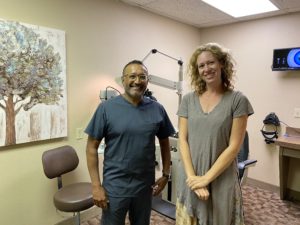
Dr. Patel in one of his practice’s exam rooms with a staff member, Trisha, who leads patient reception in the office. Dr. Patel says that he takes seriously his role as a leader in inspiring staff to provide a high level of care and service to patients.
By Raj Patel, OD, FAAO
Feb. 1, 2023
Leading any business is a challenge, and when you throw in the need to provide a high level of patient care, a practice owner is up against a lot. Here are the leadership approaches that have helped my team and I achieve a practice that saw 4-7 percent revenue growth for 10 years in a row.
Maintain a Proactive Service Mentality–Even as Your Team Grows & Changes
As our team grew and changed through the years, it became difficult for new staff members to have the mindset to go above and beyond in their job roles. When you bring in new staffers, you bring in their mindset, their ability to work with teams and their energy. The veterans on the team know that for us to create positive patient experiences, we have to exceed their expectations.
When you bring in new employees, who do not come from this type of business culture, they need to see examples of proactive attention toward patients from the team they are joining. For instance, we trained our staff to let patients know at check-in if we are running behind schedule, and then to attend to the patient while they wait, rather than letting the patient sit for a long time in our reception area unattended.
Another way we maintain a proactive service mentality in our office is noting the date we told patients their glasses would be ready, and ensuring we deliver it by that date. That requires calling the lab, checking on the status and preemptively sending the patient a text about delays, should they occur.
The two main reasons why patients fire their clinics are issues around how the staff made them feel and not understanding their charges. For those reasons, we focus on providing a clear explanation of fees and having positive encounter points between the patient and members of the staff during the care cycle, reducing potential friction points.
When we see examples of employees going beyond, we recognize it promptly–in the moment we see it or at the next staff meeting. Sometimes our long-time staff members see a new employee exceeding a patient’s expectations, and they bring attention to it. For example, a veteran team member sees a newer staff member walking an elderly patient to their car with an umbrella on a rainy day, or seamlessly checking in a late patient and getting them connected to a tech quickly. Staff-to-staff recognition is a great way to solidify a proactive service approach to working with patients.
Communicate Your Practice Brand Consistently to Staff
Recognize that as practice leader, you are always on stage, setting the tone for your whole team. How you address colleagues and employees, including the words you use, the unspoken words (how you leave your exam lane, body language, how quickly you reply to staff e-mails, how you dress, whether you say good morning or “great day today” at the end of the day, etc.) leaves an imprint on staff, framing how they think about you and the practice.
For many years, when we did optician training around lens designs, I always led with why these designs or materials were better for the patient. Then, one year, I noticed that usage of those designs was low, so I had a meeting with my most senior optician about this. Everyone on the team respected this person. It was early in my career, and the message I unintentionally sent that person was we need to use these designs because they cost less for our practice. That respected and tenured optician concluded that the focus of our office had changed, and now was on offering cheap lenses. He relayed that back to our other five opticians, and almost immediately, their perception of my brand changed–for the worse.
Other Articles to Explore
It took many months to re-frame that message, so our team understood that our practice brand was still, and always would be, to consider first what is best for the patient. I learned from this experience that as leaders we always need to think about how we explain practice changes and improvements, so our staff understands the underlying values of our practice, and what should be most important to them as they do their work.
Guide Employees to Overcome Fear of Failure
Many years ago, I had a tech who would walk the patient from the reception area to the pre-testing room (autorefraction, tonometry, retinal imaging), then into the exam lane, close the door and let me know, “the patient is ready for you.” I found it frustrating that the patient was “parked” in the room without having other measurements taken (chief complaint and visual acuity at least, recorded into the EHR).
A couple months later, we had a talk. I told this employee, “I think you are eventually going to want an increase in your wages, which would be reasonable. When the time comes for that conversation, you will want to ask yourself, ‘What have I done to add value to this organization?’ Walking the patient down the hall will not be enough. The best way to add value is to grow yourself, so you are confident in performing more of the data collection as a tech.”
The employee told me the reason she did not do anything with the patient other than park them in the exam room was because she was afraid of making a mistake. As a result, she felt the safest approach was to not even try. I reassured this employee that as long as she made her best effort to serve the patient, rather than leaving them neglected, we would help her correct any mistakes she might make.
I let staff know that learning from their mistakes by being open to feedback is how their value to our patients and practice will grow. I also make a point of noting to employees when they do the right thing. If the only time we give feedback to our staff is when there is a mistake, we will not get the results we are after. We have to be intentional in offering positive feedback to a much greater degree than instructional feedback. That way, when the time comes for a correction, they will feel secure enough about their job performance to take in the feedback and work with you to do even better.

Raj Patel, OD, FAAO, is a partner with Vancouver Vision Clinic, which has two locations in Vancouver, Wash. The practice is one of CooperVision’s Best Practices. To contact him: raj.patel@vancouvervision.com

























